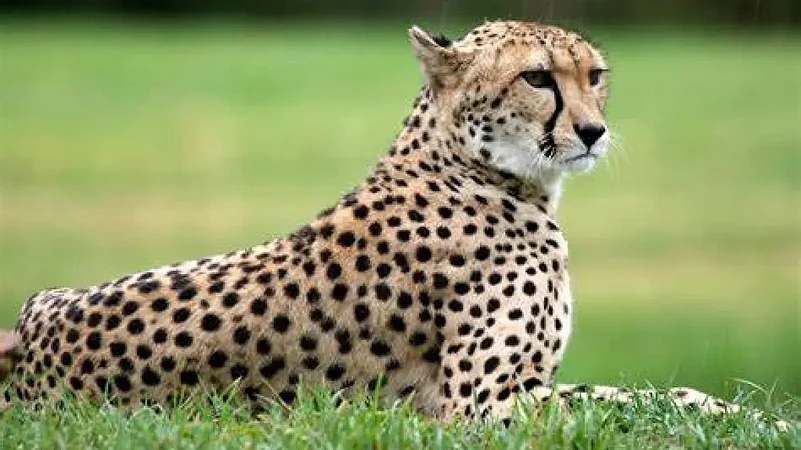Prime Minister Narendra Modi will release cheetahs brought from Namibia in Africa in Kuno National Park (KNP) in Madhya Pradesh on Saturday.
Eight cheetahs —five females and three males— will be brought from Namibia to Gwalior airport in a customised Boeing 747-400 aircraft. From there, cheetahs will be shifted to KNP helipad in an Indian Air Force (IAF) Chinook helicopter.
Cheetah was officially declared extinct in India in 1952. The last cheetah was killed in 1947.
The introduction of Cheetah in India is being done under Project Cheetah, which is world’s first inter-continental large wild carnivore translocation project, according to the Prime Minister's Office.
Here we explain the idea behind cheetah reintroduction, how cheetahs went extinct, the history of cheetahs in India, and why some are criticising their reintroduction.
Reintroducing cheetahs in India
Cheetahs are being reintroduced in India seven decades after they were declared extinct.
"Cheetahs will help in the restoration of open forest and grassland ecosystems in India. This will help conserve biodiversity and enhance the ecosystem services like water security, carbon sequestration and soil moisture conservation, benefiting the society at large," said the Prime Minister's Office.
However, cheetahs being reintroduced are African Cheetahs. The cheetahs indigenous to India that went extinct are Asiatic Cheetahs that are today only found in very small numbers in Iran.
In fact, the first choice for cheetahs' reintroduction was Iran and negotiations were on with the Shah of Iran in 1970s. However, the overthrowal of Shah's regime in the 1979 Islamic Revolution of Iran put the initiative to an end.
Cheetahs will be in a quarantine period for a month before being released into the wild. At first, they would be released into an electronically-fenced area of 500 hectares.
"The animals will first go through a 'soft-release' where they will be monitored within a 500-hectare, electrically-fenced area. Leopards from this area will also be moved," reported DailyO.
The time cheetahs prowled in India
The "word" cheetah is believed to have come from the Sanskrit word "chitraka", which means the dotted one.
PTI reports that cave paintings dating back to the Neolithic age depict the cheetah in Gujarat and Madhya Pradesh, suggesting that cheetahs were known to be in India from ancient times.
Except for the Northeastern, coastal, and mountaineous areas, cheetahs were known to prowl across the country, particularly in the Central India.
Divyabhanusinh in his book The End of a Trail – The Cheetah in India writes that cheetahs roamed the semi-desert areas, scrub jungles, and grasslands of India, as these were the areas most suitable to the big cat, allowing it to sprint with minimal obstructions to hunt.
He further writes that cheetah was domesticated by kings and nobles and were used for coursing and hunting. Unlike the leopard, cheetahs were never known to attack humans and were therefore easy to tame and train.
Cheetahs under the Mughals
Cheetahs were recorded extensively through the Mughal period. The Mughals also used cheetahs in their hunts which they loved.
"The Mughal emperors' penchant for hunting was remarkable and was on a scale larger than life. Hunting with cheetahs was among the foremost pastimes, if not the ultimate royal sport of the Mughals. Miniature paintings provide excellent visuals of the cheetah's lifestyle at court," wrote Divyabhanusinh, who also notes that Akbar was the first Mughal emperor introduced to cheetah by one of his nobles.
Akbar is also recorded to have captured cheetahs as an emperor from present-day Madhya Pradesh. At times, cheetahs were also hunted and it is documented that Jahangir hunted a an unspecified number of cheetahs.
Cheetahs were liked by the Mughals and the nobles. As a result, a network to catch and supply cheetahs to the royals developed.
Divyabhanusinh writes, "In order to keep the empire supplied with cheetahs, an elaborate organisation developed and specific areas were earmarked for catching cheetahs from the wilds. They were the environs of Pattan, Bhatnair, Bhatinda and Hissar in Punjab/Haryana; Jodhpur, Nagaur, Merta, Jhunjhunu, Amarsar adn Dholpur in Rajasthan; Nawanagar (Jamnagar) and Sidhpur in Gujarat; and Alapur near Gwalior in Central India."
Extinction of cheetahs under the British rule
While cheetahs were trapped and hunted during the Mughal rule, it was more of former than the latter.
It was the British rule that saw their hunting as a sport which led to their eventual extinction, along with some other factors such as loss of habitat because of growing human population and pressure of forests with expanding human settlements.
The Print notes that the attitude towards cheetahs changed under the British rule who began to put bounty on their heads.
It cited environmental historian Mahesh Rangarajan's research and reported, "Cheetahs were bounty-hunted by the colonial administration in fairly large numbers, with rewards ranging from Rs 6 for cubs to up to Rs 18 for an adult. According to his research, between 1870 and 1925 the average number of cheetahs killed for rewards was 1.2 a year. This is higher than the number of cheetahs killed and speared between 1800 and 1950, which totalled 127, or a statistical average of less than one a year."
"Bounty-hunting, therefore, may have hastened, if not caused, its decline in many localities where it still survived," Rangarajan is quoted as having written in a paper.
The hunting by the British also inspired the Indian princely states to hunt them, which were already hunting bigger cats such as tigers.
Divyabhanusinh in his book cites surveys and writes that "cheetahs were already becoming rare in the 19th century and much more so in the 20th."
The last Indian cheetahs
The last Indian cheetahs are believed to have died in 1947. They were formally declared extinct in 1952.
Maharaja Ramanuj Pratap Singh Deo of Korea in present-day Madhya Pradesh is believed to have killed the last three Indian cheetahs in 1947.
Concerns for the reintroduction of cheetahs
While the government is excited to re-introduce an animal long forgotten to have existed in India, experts have voiced concerns and have questioned the exercise.
These concerns range from questions over the survival of cheetahs being reintroduced and the relevance of the entire exercise.
National Geographic reported experts as saying that cheetahs are likely to stray outside of territory marked for them are likely to be killed by people, dogs, or suffer starvation.
"There’s not any chance for free-ranging cheetah populations now," National Geographic quoted independent conservation scientist Arjun Gopalaswamy as saying, who added that Cheetahs in India "perished for a reason" and that reason —human pressure— has only got worse in the 70 years since the species disappeared. He adds, "So the first question is, why is this attempt even being made?"
Experts have also higlighted that cheetahs will be in a area which is between the areas populated by leopards and tigers. If these bigger cats attack cheetah or compete with it for food, cheetah would struggle for survival as it cannot survive against stronger leopards or tigers.
"I'm not against the project, I'm against this very tunnel vision thing of just bringing cheetahs and dumping them in the middle of India where there are 360 people per square kilometer. It's putting the cart before the horse," said Ullas Karanth of Center for Wildlife Studies.
Ravi Chellam, the CEO of Metastring Foundation and Coordinator of Biodiversity Collaborative, called the cheetah reintroduction a "vanity project".
"This initiative to get African cheetahs is neither science-based nor a national conservation priority. Unfortunately, this will significantly distract from higher priority conservation issues like the much-delayed lion translocation. For above reasons, I cannot find a diplomatic way to state it other than calling the cheetah introduction a vanity project," wrote Chellam in an article for Outlook.
He further noted that there are other species for conservation purposes in India and then there is the much-needed lions trans-location project. Reintroducing cheetahs is, therefore, a misplaced priority, according to Chellam.


























